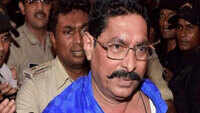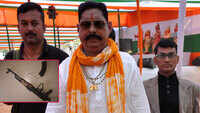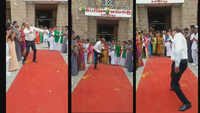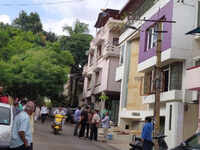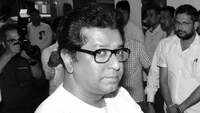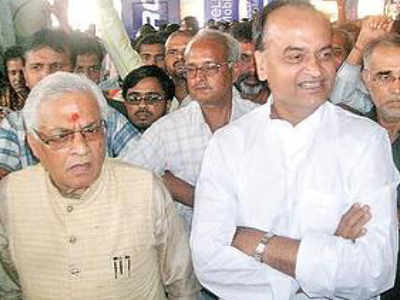
PATNA: Jagannath Mishra, who passed away in Delhi on Monday, was just 38 when he was given the charge as Bihar’s youngest chief minister in April 1975, replacing Abdul Ghafoor amid the students’ movement led by Jayaprakash Narayan.
Fondly called ‘Doctor Saheb’ by his supporters on account of his PhD, Mishra started his career as a lecturer, went on to become a professor of economics at Bihar University, Muzaffarpur, before taking the plunge into politics soon after the assassination of his elder brother and then Union minister Lalit Narayan Mishra on January 3, 1975 at Samastipur railway station.
He survived the blast that claimed his elder brother’s life, despite being badly wounded, and within three months of the incident, was anointed the chief minister of Bihar. Senior Mishra had been a close political advisor of then PM Indira Gandhi while she battled the ‘Syndicate’ before the 1969 split in the Congress. On becoming CM, Jagannath Mishra cultivated the then “rising star” of the Congress Sanjay Gandhi.
With such a political pedigree and clout, it was natural that Mishra should become the CM a second time after Janata Party was defeated in the 1980 state assembly polls. His third and shortest stint as CM came after the infamous Bhagalpur riots (1989) when then PM Rajiv Gandhi put him in the saddle, replacing Satyendra Narayan Singh.
However, the Bhagalpur riots blighted the return of the Congress to power on its own steam, leaving Mishra as the last Congress CM of the state.
Mishra’s public life began after getting elected as an MLC in 1968 from the Tirhut teachers’ constituency. In his 51-year-long career he had no dearth of admirers and detractors, who gave him the nickname “Mohammad Jagannath” for making Urdu the second language of the state after Hindi.
Yet, his legacy is his contribution to the state’s economic and infrastructural development—Mahatma Gandhi Setu, creation of industrial area development authority and imposing a cess on mineral ores exported to other states that increased the state’s revenue earnings from Rs 30 crore to around Rs 600 crore in 1981.
“When I go down the memory lane, it seems destiny gave me opportunities to work, but it also gave me a lot of insult and pain,” Jagannath Mishra said in a booklet on his “achievements.”
He was unceremoniously removed from the post of CM on August 14, 1983, replacing him with Chandrasekhar Singh a day before the Independence Day celebrations. That made him go into a combative mode, forming his Jan Vikas Manch, independent of the Congress, and launched a campaign called ‘Bihar Ki Peeda Se Judiye.’ He later established his own newspaper, Patliputra Times, and used it to fight the three Congress CMs – Bindeshwari Dubey, Bhagwat Jha Azad and Satyendra Narayan Singh.
Indeed, the 51 years of his public life could be easily divided into two parts. For the first 28 years, he remained a pillar in the state Congress, loved by his beneficiaries and disliked by dissidents and critics with most of them divided into pro- and anti-Mishra camps.
It was in the second part of his career lasting 23 years that he largely went into wilderness owing to his alleged involvement in the fodder scam in 1996. Then Prime Minister P V Narasima Rao made him a Union minister, but it proved to be merely a flash in the pan as the fodder scam soon caught the headlines. He switched parties and groups, finally joining the JD(U), while his youngest son and former minister Nitish Mishra later quit the JD(U) and joined the BJP.
The former CM Jagannath Mishra died on Monday morning at his Delhi residence at 82, leaving behind a legion of mourners who had been a part of his 51-year public life till his death.
Fondly called ‘Doctor Saheb’ by his supporters on account of his PhD, Mishra started his career as a lecturer, went on to become a professor of economics at Bihar University, Muzaffarpur, before taking the plunge into politics soon after the assassination of his elder brother and then Union minister Lalit Narayan Mishra on January 3, 1975 at Samastipur railway station.
He survived the blast that claimed his elder brother’s life, despite being badly wounded, and within three months of the incident, was anointed the chief minister of Bihar. Senior Mishra had been a close political advisor of then PM Indira Gandhi while she battled the ‘Syndicate’ before the 1969 split in the Congress. On becoming CM, Jagannath Mishra cultivated the then “rising star” of the Congress Sanjay Gandhi.
With such a political pedigree and clout, it was natural that Mishra should become the CM a second time after Janata Party was defeated in the 1980 state assembly polls. His third and shortest stint as CM came after the infamous Bhagalpur riots (1989) when then PM Rajiv Gandhi put him in the saddle, replacing Satyendra Narayan Singh.
However, the Bhagalpur riots blighted the return of the Congress to power on its own steam, leaving Mishra as the last Congress CM of the state.
Mishra’s public life began after getting elected as an MLC in 1968 from the Tirhut teachers’ constituency. In his 51-year-long career he had no dearth of admirers and detractors, who gave him the nickname “Mohammad Jagannath” for making Urdu the second language of the state after Hindi.
Yet, his legacy is his contribution to the state’s economic and infrastructural development—Mahatma Gandhi Setu, creation of industrial area development authority and imposing a cess on mineral ores exported to other states that increased the state’s revenue earnings from Rs 30 crore to around Rs 600 crore in 1981.
“When I go down the memory lane, it seems destiny gave me opportunities to work, but it also gave me a lot of insult and pain,” Jagannath Mishra said in a booklet on his “achievements.”
He was unceremoniously removed from the post of CM on August 14, 1983, replacing him with Chandrasekhar Singh a day before the Independence Day celebrations. That made him go into a combative mode, forming his Jan Vikas Manch, independent of the Congress, and launched a campaign called ‘Bihar Ki Peeda Se Judiye.’ He later established his own newspaper, Patliputra Times, and used it to fight the three Congress CMs – Bindeshwari Dubey, Bhagwat Jha Azad and Satyendra Narayan Singh.
Indeed, the 51 years of his public life could be easily divided into two parts. For the first 28 years, he remained a pillar in the state Congress, loved by his beneficiaries and disliked by dissidents and critics with most of them divided into pro- and anti-Mishra camps.
It was in the second part of his career lasting 23 years that he largely went into wilderness owing to his alleged involvement in the fodder scam in 1996. Then Prime Minister P V Narasima Rao made him a Union minister, but it proved to be merely a flash in the pan as the fodder scam soon caught the headlines. He switched parties and groups, finally joining the JD(U), while his youngest son and former minister Nitish Mishra later quit the JD(U) and joined the BJP.
The former CM Jagannath Mishra died on Monday morning at his Delhi residence at 82, leaving behind a legion of mourners who had been a part of his 51-year public life till his death.
Quick Links
Lok Sabha Election Schedule 2019Lok Sabha Election NewsDelhi Capitals teamMI team 2019Rajasthan Royals 2019RCB team 2019Maharashtra Lok Sabha ConstituenciesBJP Candidate ListBJP List 2019 TamilnaduShiv Sena List 2019AP BJP List 2019Mamata BanerjeeBJP List 2019 MaharashtraPriyanka GandhiBJP List 2019 KarnatakaAMMK Candidate List 2019BJP List 2019 WBLok Sabha Elections in Tamil NaduBSP List 2019 UPNews in TamilLok Sabha Poll 2019Satta Matka 2018PM ModiMahagathbandhanNagpur BJP Candidate ListChandrababu NaiduTamil Nadu ElectionsUrmila MatondkarNews in TeluguMadras High CourtTejashwi YadavArvind KejriwalTejasvi SuryaPawan KalyanArvind KejriwalYogi AdityanathJaya PradaSatta King 2019Srinagar encounter
Get the app
